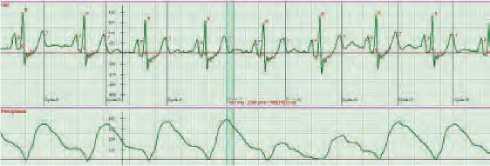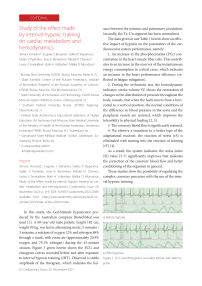Study of the effect made by interval hypoxic training on cardiac metabolism and hemodynamics
Автор: Tamara Voronina, Eugeniy Y. Bersenev, Galina P. Stepanova, Vadim V. Pyatenko, Irina А. Berseneva, Nikolai N. Chernov, Larisa V. Smekalkina, Botir А. Yuldashev, Malika D. Murodova
Журнал: Cardiometry @cardiometry
Рубрика: Editorial
Статья в выпуске: 20, 2021 года.
Бесплатный доступ
Короткий адрес: https://sciup.org/148322426
IDR: 148322426
Текст статьи Study of the effect made by interval hypoxic training on cardiac metabolism and hemodynamics
Imprint
Tamara Voronina*, Eugeniy Y. Bersenev, Galina P. Stepanova, Vadim V. Pyatenko, Irina А. Berseneva, Nikolai N. Chernov, Larisa V. Smekalkina, Botir А. Yuldashev, Malika D. Murodova. Study of the effect made by interval hypoxic training on cardiac metabolism and hemodynamics. Cardiometry; Issue 20; November 2021; p. 8-9; DOI: 10.18137/cardiometry.2021.20.89; Available from:
In this study, the Go2Altitude hypoxicator produced by the Australian company BiotechMed was used [1]. A 60-year-old male patient, height 182 cm, weight 95 kg, was fed in alternating mode, 5 minutes / 3 minutes, a mixture of oxygen 12% and nitrogen 88% through a mask, with room air (approximately 20.9% oxygen and 79.1% nitrogen) during the 45-minute session. Figure 1 given herein shows the ECG and rheogram curves recorded before and after exposure to interval hypoxic training (IHT). Observed is stable amplitude of the rheogram, which indicates the bal- ance between the systemic and pulmonary circulation. Secondly, the Tк-Uн segment has been normalized.
The data given in our Table 1 herein show an effective impact of hypoxia on the parameters of the cardiovascular system performance, namely:
-
1. An increase in the phosphocreatine (PCr) concentration in the heart muscle fiber cells. This contributes to an increase in the reserves of the instantaneous energy consumption in critical cases, which indicates an increase in the heart performance efficiency (reflected in fatigue mitigation).
-
2. During the orthostatic test, the hemodynamic indicator, stroke volume SV, shows the restoration of changes in the distribution of pressure throughout the body, namely, that when the body moves from a horizontal to a vertical position, the normal conditions of the difference in blood pressure in the aorta and the peripheral vessels are restored, which improves the tolerability to physical loading [2, 3].
-
3. The coronary blood flow is significantly restored.
-
4. We observe a transition to a better type of the adaptational reaction: the reaction of stress (rS) is eliminated with turning into the reaction of training (rT) [4].
As a result, the system indicator, the stress index (SI) value [5-7] significantly improves that indicates the correction of the coronary blood flow and better conditioning of the organism in general.
These studies show the possibility of regulating the complex coronary processes with the use of the interval hypoxic training.

a) Before hypoxia

b) After hypoxia
Figure 1. ECG and Rheograms recorded before and after hypoxia
Table 1
The effects of hypoxia on the cardiac metabolism and hemodynamics
|
No. |
Date |
Stage |
О 2 0,5...0,55; 0,6…0,65; 0,7…0,85) arb.u. |
Lactate (3...7) arb.u. |
PCr (2…4) arb.u. |
RV1 (62%) ejection fraction |
(150...300) Type of adaptational reaction |
|||||
|
l |
s |
l |
s |
l |
s |
l |
s |
l |
s |
|||
|
1 |
June, 20, 2017 |
Before using hypoxicator |
0.57 |
0.47 |
3.76 |
4.73 |
6.9 |
8.87 |
59 |
59 |
1651 Calm activation |
474 Str. |
|
2 |
After using hypoxicator |
0.50 |
0.52 |
4.49 |
4.12 |
10.4 |
11.9 |
59 |
59 |
452 Calm activation |
458 Training |
|
Список литературы Study of the effect made by interval hypoxic training on cardiac metabolism and hemodynamics
- https://www.go2altitude.com/
- Rudenko MY, Voronova OK, Zernov VA. Theoretical Principles of Heart Cycle Phase Analysis. Munchen, London, New York: Fouque Literaturverlag.; 2009.
- Rudenko MY, Kolmakov S, Weber K, Voronova OK, Zernov VA, Rudenko SM, et al. Innovation in cardiology. A new diagnostic standard establishing criteria of quantitative & qualitative evaluation of main parameters of the cardiac & cardiovascular system according to ECG and Rheo based on cardiac cycle phase analysis. Nature Precedings. doi: 10.1038/npre.2009.3667.1.
- Garkavi LKh, Kvakina YeB, Shikhlyarova AI, et al. Magnetic fields, adaptational reaktions and the self-organization of living system. Biofizika, 1996;4(41):898–905
- Baevsky RM, Chernikova AG. On issue of physiological norm: a mathematical model of functional states on the basis of analysis of heart rate variability. Aviakosmicheskaya i ekologicheskaia meditsina. 2002(6):11-17.
- Baevsky RM, Baranov VM, Funtova II, Diedrich A, Pashenko AV, Chernikova AG, et al. Autonomic cardiovascular and respiratory control during prolonged spaceflights aboard the International Space Station. J. Appl. Physiol. 2007;103:156. doi: 10.1152/japplphysiol.00137.2007.
- Baevsky RM, Ivanov GG, Tschireikin LV. Analysis of heart rate variability by use of different electrocardiodiagnostic systems. Vetsnik aritmologii. 2001;24:69-85.


